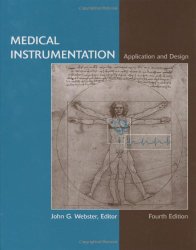Engineering Bookshelf
- Aerospace
- Biological
- Civil
- Chemical
- Environmental
- Electrical
- Materials
- Mechanical
- Petroleum
- Geoengineering
- Software

Medical Instrumentation: Application and Design
by John G. WebsterPublisher: John Wiley & Sons
ISBN: 0471676004
Check price @ amazon.com , amazon.ca , amazon.co.uk
Book Description
This well-established text describes the principles, applications and design of the medical instrumentation most commonly used in hospitals. Because equipment changes with time, the authors stress fundamental principles of operation and general types of equipment. They avoid detailed descriptions and photographs of specific models. Design principles are emphasized so that a scientist with only some background in electronics can gain enough information to design instruments that may not be commercially available. Since biomedical engineering is an interdisciplinary field, the authors have provided varied healthcare industry applications for each type of instrument.
From Book News, Inc.
New edition of a text which describes the principles, applications, and design of the medical instruments most commonly used in hospitals. Stresses fundamental principles of operation and general types of equipment rather than detailed descriptions of specific models. Fourteen chapters discuss basic concepts, sensors and principles, amplifiers and signal processing, biopotential electrodes and amplifiers, blood pressure and sound, measurement of flow and volume of blood and of the respiratory system, chemical biosensors, laboratory instrumentation and imaging systems, therapeutic and prosthetic devices, and electrical safety.
The publisher, John Wiley & Sons
This well-established text describes the principles, applications and design of the medical instrumentation most commonly used in hospitals. Because equipment changes with time, the authors stress fundamental principles of operation and general types of equipment. They avoid detailed descriptions and photographs of specific models. Design principles are emphasized so that a scientist with only some background in electronics can gain enough information to design instruments that may not be commercially available. Since biomedical engineering is an interdisciplinary field, the authors have provided varied healthcare industry applications for each type of instrument.
Customer Reviews
mentezar from Carlsbad, CA USA
Explains dynamic characteristics of circuits very well. It has a ton of information - which can be too much. If you are just starting out in a course on instrumentation, I would recommend, "Principles of Bioinstrumentation" by Normann. His book is much simpler. Ideally, you should get both,..., it depends what level you are at (as a 4th year bioengineering student, I preferred the simple version...)
A reader from karachi,Pakistan
This book is very good about medical devices and application
edmond@pkrisc.cc.ukm.my from Malaysia
It was with great enthusiasm that we ordered the 3rd edition of Professor's Webster big hit. With all my respects for Professor Webster, I was personally disapointed to observe that this edition has almost the same content as the second one. Maybe it is worth mentioning that I have adopted this text for my bioinstrumentation course from the very first edition. It is amazing that some of the very good and recent works done by Prof. Webster's team of engineers and students was not at all included. Even the references are almost the same as the second edition. As the second edition had really something to say compared to the first one, the natural expectation was to see a 3rd edition much more elaborated in terms of novelties in the field. The amount of new material put into this edition seems not to justify the publication of the 3rd edition.